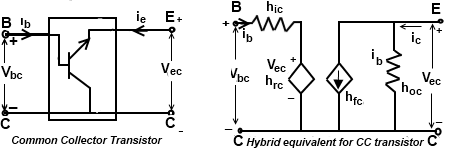Hybrid Equivalent For CC Transistor
The figure shows the transistor connected in common emitter configuration and the figure also shows the hybrid equivalent circuit of such a transistor.
In common emitter transistor configuration, the input signal is applied between the base and emitter terminals of the transistor and output appears between the collector and base terminals. The input voltage (Vbc) and the output current (ic) are given by the following equations:
Vbc = hic.ib + hre.Vec
ie = hfe.ib + hoe.Vec

Hybrid expression
Expression can be obtained from the general hybrid formulas derived in this article Hybrid Equivalent of Transistor by adding a second subscript letter ‘b’ (which stands for common Collector) with the h-parameters and are as discussed below.
Current Gain
It is given by the relation,
Ai = -(hfc/(1 + hoc.rL))
Where rL is the A.C load resistance. Its value is equal to the parallel combination of resistance RE and RC. Since hfe of a transistor is a positive number, therefore Ai of a common emitter amplifier is negative.
Input Resistance
The resistance looking into the amplifier input terminals (i.e. base of a transistor) is given by the relation,
Ri = hie + hre.Ai.rL = hie – ((hrc.hfc)/(hoc + (1/rL)))
The input resistance of the amplifier stage (called stage input resistance Ris) depends upon the biasing arrangement. For a fixed bias circuit, the stage input resistance is,
Ris = Rs
Voltage Gain
It is given by the relation,
Av = Ai.r1/Ri
Since the current gain (Ai) of a common base amplifier is positive, therefore the voltage gain (Av) is also positive. It means that there is no phase difference between the input and output signals of the common base amplifier. The voltage gain, in terms of h-parameters, is given by the relation.
Av = hfc.rL/(hic + ∆h.rL)
Where
∆h = hic.hoc – hrc.hfc
Output Resistance
The resistance looking into the amplifier output terminals is given by the relation,
Ro = (Rs + hic)/(Rs.hoc + ∆h)
Where
Rs = Resistance of the source, and
∆h = hic.hoc – hrc.hfc
Overall Voltage Gain
It is given by the relation,
Avc = (Av.Ris)/(Rs + Ris)
Overall Current Gain
It is given by relation,
Ais = (Ai + Rs)/(Ri + Ris)
Example
A transistor used in a common collector amplifier has the following vaules of h-parameters:
hic = 2 KΩ, hfc = -.51, hrc = 1 and hoc = 25 X 10-6mhos
Calculate the values of input resistance, output resistance, current gain and voltage gains of the amplifier stage.
Solution
Given Data:
hic = 2 KΩ = 2000 Ω
hfc = -.51
hrc = 1
hoc = 25 X 10-5mhos
rL = RE = 5 KΩ = 5 X 103 Ω
Rs = 1 KΩ = 1000 Ω
R1= R2 = 10 KΩ
Input resistance of the amplifier stage
We know that the input resistance,
Ai = -(hfc/(1 + hoc.rL))
= -51/[1 + {(25 x 10-6) x (5 x 103)}]
= 45.3
and input resistance
Ri = hie + hre.Ai.rL
= 2000 + (1 x 45.3 x 5 x 103 Ω
= 228 x 103Ω
= 228 kΩ
As input resistace of the amplifier
Ris = R1 // (R1 // R2)
= 228 // (10 // 10) = 4.9 kΩ
= 4900 Ω Ans
Output Resistance of Amplifier Stage
We know that:
Ro = - (Rs + Ric)/hfc
= - ( 1000 + 2000)/-51
= 59 Ω
and output resistance of the amplifier stage
Ros = Ro // RE
= 59 // ( 5 x 10-3)
= 58.3 Ans
Current Gain
We know that the current gain of amplifier stage,
Ais = -(Ai.Rs)/(Rs.Ris) = (45.3 x 1000)/(1000 + 4900) = 7.7 Ans.
Voltage Gain Amplifier Stage
We know that voltage gain is
Av = Ai.rL/Ri = (45.3 X ( 5 x 103) / 228 x 103= 1 Ans.
and the voltage gain of the amplifier stage
Avs = Av.Ais/(Rs + Ris) = (1 + 4900)/ (1000 + 4900) = 0.83 Ans
